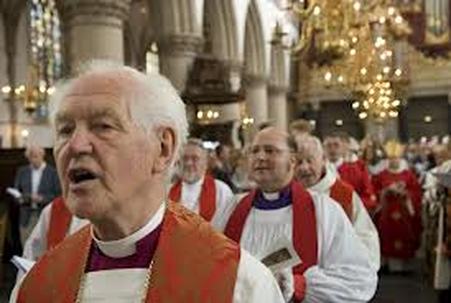CHRISTIANS OLD CATHOLICS OF CENTRAL-EASTERN EUROPE

The Bishop Willibrord and
his colleagues developed the area of Europe known as the Netherlands
(Belgium, Netherlands and Luxembourg) to the Catholic faith in the
seventh century.
In 1145, Pope Eugenio III recognised the right of the chapter of the
Cathedral of Utrecht to choose successors to the headquarters.
The fourth Lateran Council conferred the right to choose its own bishops
to all the Cathedral chapters.
Pope León X, in its 'Debitum Pastoralis' letter, dated 1520, granted Philippi of Burgundy, the 57mo. Bishop of Utrecht, and his successors, internal autonomy in Ecclesiastical Affairs. This Government legitimate, without a doubt, both Catholicosate of the headquarters in Utrecht, as the of all the Anneli, thereafter.
In Nuremberg, August 27, 1870, by professors from Bonn, Breslau, Bmunsberg, Munich, Münster, Prague, and elsewhere, who, under the leadership of Johann Josef Ignaz von Döllinger made the statement against the Decree of the Vatican Council. A meeting of laity in Königswinter in September of the same year ruled that: "whereas that Council... not deliberated in an environment of perfect liberty... Catholics who sign below [1,359 total] do not recognize the decrees about the absolute power of the Pope and his infallibility as an Ecumenical Council decision, moreover, reject them as innovations that will direct contradiction to the uniform faith of the Church". The Declaration of Utrecht solidified this movement in 1889. It is this line that it recognizes, adheres and reflects its Synodality, our Priestly Society of Saint Ignatius of Loyola.
Pope León X, in its 'Debitum Pastoralis' letter, dated 1520, granted Philippi of Burgundy, the 57mo. Bishop of Utrecht, and his successors, internal autonomy in Ecclesiastical Affairs. This Government legitimate, without a doubt, both Catholicosate of the headquarters in Utrecht, as the of all the Anneli, thereafter.
In Nuremberg, August 27, 1870, by professors from Bonn, Breslau, Bmunsberg, Munich, Münster, Prague, and elsewhere, who, under the leadership of Johann Josef Ignaz von Döllinger made the statement against the Decree of the Vatican Council. A meeting of laity in Königswinter in September of the same year ruled that: "whereas that Council... not deliberated in an environment of perfect liberty... Catholics who sign below [1,359 total] do not recognize the decrees about the absolute power of the Pope and his infallibility as an Ecumenical Council decision, moreover, reject them as innovations that will direct contradiction to the uniform faith of the Church". The Declaration of Utrecht solidified this movement in 1889. It is this line that it recognizes, adheres and reflects its Synodality, our Priestly Society of Saint Ignatius of Loyola.
- In Mariology, we reject the dogmas of the Immaculate conception and the bodily assumption of Mary into heaven.
- However, we remind you we respect as mother in special days according to the ancient liturgy, as well as the saints.
- We have no problem with images in the temples although we are sober to do so, but keep some referencing for some Saints.
- We accept the triple Ministry of the diaconate, presbytery and episcopate, thus constituting the sacrament of orders.
- We do not accept celibacy required for priests, and theymay they enter into marriage; as well as not the monarchical episcopate.
- We recognize the primacy of Peter, we do not accept a direct Ministry succession, as it defends the Roman Catholic tradition.
- The bishops are elected by synods, clerics and laymen enjoy equality in the synods. We accept the seven sacraments, three of whom have indelible character, reorientation we have given some typical rituals, such as auricular confession, i.e. to confess to a priest freely and unconditionally.
- Baptism may be administered by immersion, infusion or spraying.
- We celebrate the Eucharistic supper in the vernacular language in the churches and not in latin, and communion is always distributed under both species.

